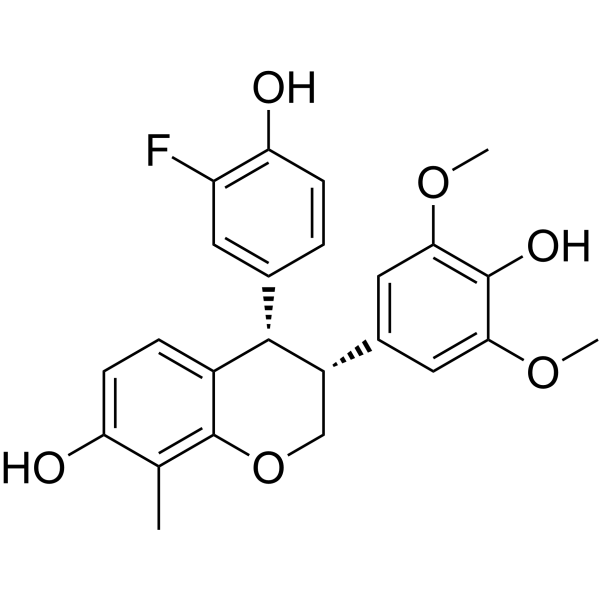Physicochemical Properties
| Molecular Formula | C24H23FO6 |
| Molecular Weight | 426.43 |
| CAS # | 1983180-82-0 |
| Appearance | Solid powder |
| Synonyms | TRX-E-009-1 |
| HS Tariff Code | 2934.99.9001 |
| Storage |
Powder-20°C 3 years 4°C 2 years In solvent -80°C 6 months -20°C 1 month Note: This product requires protection from light (avoid light exposure) during transportation and storage. |
| Shipping Condition | Room temperature (This product is stable at ambient temperature for a few days during ordinary shipping and time spent in Customs) |
Biological Activity
| ln Vitro | Trilexium shows activity against multiple cancer types. Among 240 cell lines evaluated in Eurofin's Oncopanel, 10 cell lines showed IC50 > 30 μM, and among the remaining 230 cell lines, the average IC50 was 0.428 μM[1]. Trilexium (300 nM, 4 h) disrupts the microtubule network in Hela cells[1]. Trilexium (1-5 μM) leads to increased protein expression of p21, c-PARP, and c-Caspase 3 in HSJD-DIPG007 cells[2]. Trilexium (0-2 μM) restores H3K27 trimethylation and increases H3K27 acetylation in HSJD-DIPG007 cells[2]. |
| ln Vivo | Trilexium (5-60 mg/kg, intravenously administered daily for 15 days) can significantly reduce tumor volume in the body [1]. Trilexium (80 mg/kg intravenously daily for 5 days) disrupts microtubules in the body [1]. |
| Animal Protocol |
Animal/Disease Models:C57/BL6 mice (n = 8 mice per group, subcutaneous mouse xenograft model of BRAF mutant (BRAFV600E) melanoma (A375))[1] Doses: 5 and 60 mg/kg Route of Administration: IV (tail vein injection), daily for 15 days Experimental Results: Resulted in a tumour growth inhibition at 60 mg/kg. Significantly improved survival at 60 mg/kg. |
| References |
[1]. Mechanism of action of the third generation benzopyrans and evaluation of their broad anti-cancer activity in vitro and in vivo. Sci Rep. 2018 Mar 23;8(1):5144. [2]. Microtubule-Targeting Combined with HDAC Inhibition Is a Novel Therapeutic Strategy for Diffuse Intrinsic Pontine Gliomas. Mol Cancer Ther. 2023 Dec 1;22(12):1413-1421. |
Solubility Data
| Solubility (In Vitro) | DMSO : 300 mg/mL (703.52 mM; with sonication) |
| Solubility (In Vivo) |
Solubility in Formulation 1: ≥ 5 mg/mL (11.73 mM)(saturation unknown) in 10% DMSO 40% PEG300 5% Tween-80 45% Saline (add these co-solvents sequentially from left to right, and one by one), clear solution . For example, if 1 mL of working solution, add 100 μL of 50.0 mg/mL clear DMSO stock solution to 400 μL PEG300 and mix well; then add 50 μL Tween-80 to the above system and mix well; then add 450 μL saline to make up to 1 mL. *Preparation of saline: Dissolve 0.9 g of sodium chloride in 100 mL ddH₂ O to obtain a clear solution. Solubility in Formulation 2: ≥ 5 mg/mL (11.73 mM)(saturation unknown) in 10% DMSO 90% (20% SBE-β-CD in Saline) (add these co-solvents sequentially from left to right, and one by one), clear solution This protocol will produce a clear solution of ≥ 5 mg/mL (saturation unknown). . For example, if 1 mL of working solution, add 100 μL of 50.0 mg/mL clear DMSO stock solution to 900 μL of 20% SBE-β-CD in saline and mix well. *Preparation of 20% SBE-β-CD in Saline (4°C,1 week): Dissolve 2 g SBE-β-CD in 10 mL saline to obtain a clear solution. (Please use freshly prepared in vivo formulations for optimal results.) |
| Preparing Stock Solutions | 1 mg | 5 mg | 10 mg | |
| 1 mM | 2.3451 mL | 11.7253 mL | 23.4505 mL | |
| 5 mM | 0.4690 mL | 2.3451 mL | 4.6901 mL | |
| 10 mM | 0.2345 mL | 1.1725 mL | 2.3451 mL |
